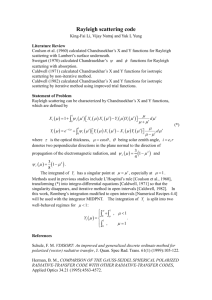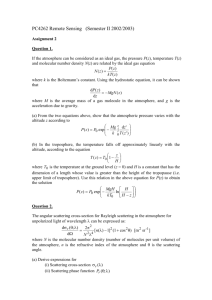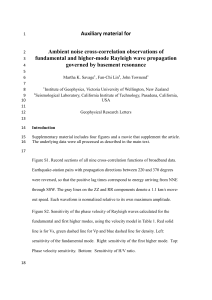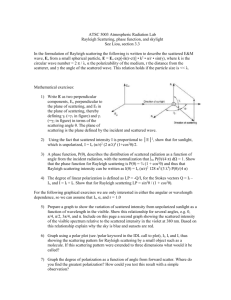Molecular Velocity Distribution in Air
advertisement
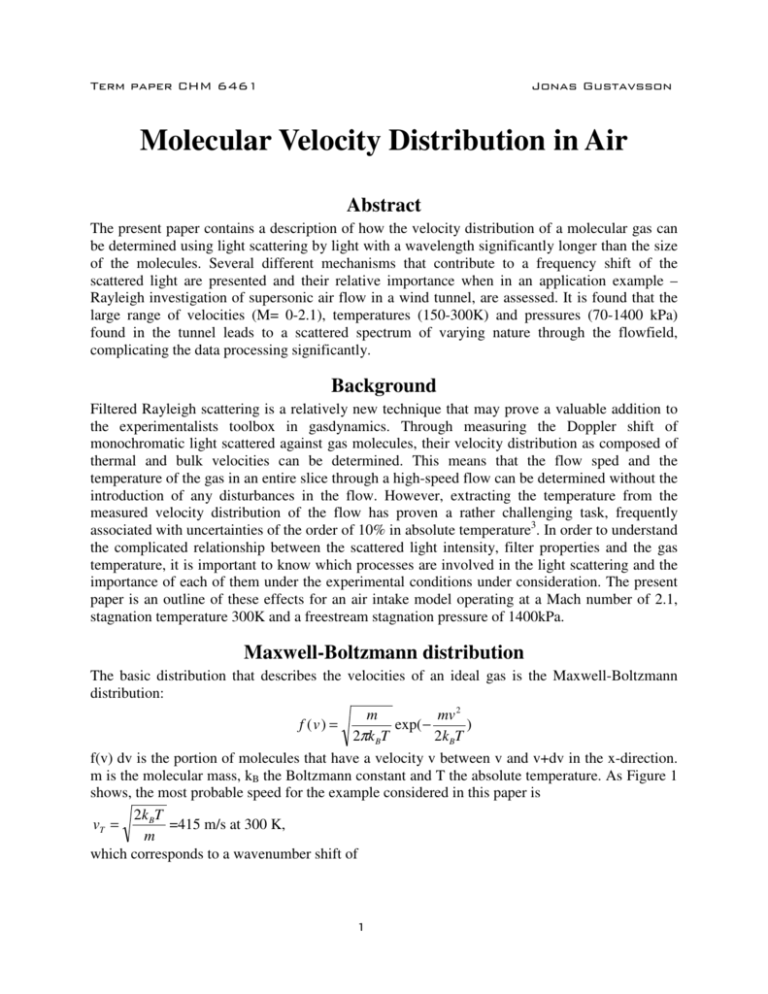
7HUPSDSHU&+0 -RQDV*XVWDYVVRQ Molecular Velocity Distribution in Air Abstract The present paper contains a description of how the velocity distribution of a molecular gas can be determined using light scattering by light with a wavelength significantly longer than the size of the molecules. Several different mechanisms that contribute to a frequency shift of the scattered light are presented and their relative importance when in an application example – Rayleigh investigation of supersonic air flow in a wind tunnel, are assessed. It is found that the large range of velocities (M= 0-2.1), temperatures (150-300K) and pressures (70-1400 kPa) found in the tunnel leads to a scattered spectrum of varying nature through the flowfield, complicating the data processing significantly. Background Filtered Rayleigh scattering is a relatively new technique that may prove a valuable addition to the experimentalists toolbox in gasdynamics. Through measuring the Doppler shift of monochromatic light scattered against gas molecules, their velocity distribution as composed of thermal and bulk velocities can be determined. This means that the flow sped and the temperature of the gas in an entire slice through a high-speed flow can be determined without the introduction of any disturbances in the flow. However, extracting the temperature from the measured velocity distribution of the flow has proven a rather challenging task, frequently associated with uncertainties of the order of 10% in absolute temperature3. In order to understand the complicated relationship between the scattered light intensity, filter properties and the gas temperature, it is important to know which processes are involved in the light scattering and the importance of each of them under the experimental conditions under consideration. The present paper is an outline of these effects for an air intake model operating at a Mach number of 2.1, stagnation temperature 300K and a freestream stagnation pressure of 1400kPa. Maxwell-Boltzmann distribution The basic distribution that describes the velocities of an ideal gas is the Maxwell-Boltzmann distribution: m mv 2 f (v) = exp( − ) 2πk BT 2 k BT f(v) dv is the portion of molecules that have a velocity v between v and v+dv in the x-direction. m is the molecular mass, kB the Boltzmann constant and T the absolute temperature. As Figure 1 shows, the most probable speed for the example considered in this paper is 2 k BT vT = =415 m/s at 300 K, m which corresponds to a wavenumber shift of 7HUPSDSHU&+0 ∆kT = 2vT sin λc -RQDV*XVWDYVVRQ θ 2 =0.037 cm-1 at 300K and 0.026 cm-1 at 150K. −3 1.5 x 10 N 2 O2 air f(v) (s/m) 1 0.5 0 −1000 −500 0 v (m/s) 500 1000 Figure 1.Maxwell-Boltzmann distributions for nitrogen, oxygen and air at 300K. Outline of complicating phenomena The Maxwell-Boltzmann distribution function that was presented in the preceding section is only valid for a rather narrow range of conditions, namely for ideal gases, i e monatomic gases so dilute that collisions between gases can be ignored, at thermal equilibrium. To achieve higher accuracy in the more general case of a polyatomic gas with interacting molecules of finite size at off-equilibrium conditions, it is necessary to develop more advanced models. These models will essentially deal with the finer structure of the Rayleigh-scattered light, some of which turns out to be frequency shifted due to the internal degrees of freedom of the gas or acoustic interactions between the gas molecules. In the literature, there is a great deal of confusion over the naming of the different peaks that may be observed as one takes a closer look at the “unshifted” Rayleigh light. In this report, the definitions outlined in Young1 will be followed. Internal degrees of freedom While monatomic gases lack internal degrees of freedom, polyatomic molecules will have both rotational and vibrational degrees of freedom. Linear molecules have two rotational degrees of freedom and molecules without this rotational symmetry has three. The remaining 3n-3 or 3n-2 7HUPSDSHU&+0 -RQDV*XVWDYVVRQ degrees of freedom (where n is the number of atoms in the molecule), respectively, will be vibrational. Due to the high energies of the vibrational energies of nitrogen and oxygen molecules, the majority of molecules are in the vibrational ground state up to the characteristic vibrational temperature θv=hn0c/kB=3500K for N2 and 2300K for O2. The rotational levels are, however, populated even at the temperatures of interest here (150-300K). These will give rise to frequency-shifted so-called Raman lines surrounding the main (Cabannes) line of the Rayleigh scattered light. The wave vector shift by permitted rotational transitions are given by: ∆k = ±2 B (2∆J + 1), ∆J = 1,2,3,... For nitrogen B=2.00 cm-1 and for oxygen 1.45 cm-1 showing that the distance between the central Cabannes line and the nearest Raman shifted (Stokes and anti-Stokes) vibrational lines is 8.7 cm1 (corresponding to a wavelength shift of 0.25 nm) in air. θr=6hBc/kB=12.5 K gives an estimate above which temperature there will be significant populations of the excited levels. In the present temperature range, there will be a few dozen Raman-shifted peaks covering a range of a few hundred cm-1 of the spectra. Fortunately, the Raman-shifted light will be an order of magnitude less intense than the Cabannes line. According to Young, the ratio between Raman and Cabannes intensities for vertically polarized incident light (typically used for Rayleigh scattering setups) will be given by: I Raman 21ε = ≈0.025 for air which has a polarization anisotropy of ε=0.22. I Rayleigh 180 + 28ε Comparing the Raman shifts to the pass-band width of the filters commonly used for Rayleigh scattering, which tends to be of the order of 0.03 cm-1, it is clear that the Raman shifted light will be well out of the used transmission line. It is however important to make sure that no Raman light gets shifted away to another transmission band of the filter used, since the iodine cells frequently used as filters for Rayleigh scattering has a multitude of transmission bands, see Figure 3. 7HUPSDSHU&+0 -RQDV*XVWDYVVRQ 1 0.9 0.8 Transmission 0.7 0.6 0.5 0.4 0.3 0.2 0.1 0 −1 −0.5 0 −1 k−18788 cm 0.5 1 Figure 2. Transmission spectrum for iodine vapor filter (Tcell=80 oC) around the Nd:YAG laser wavelength 532.8 nm used for Rayleigh scattering (calculated using program obtained from Forkey et al2). Collisional effect Depending on the density of the gas under study, three different regimes are identified based on the ratio between the intra-molecular and scatterer-molecule collision frequencies, y as defined3 below. 2 P α θ y= , k = sin , α = kvT 2 µ λ α is the collision frequency, k the incident light wavevector, vT the thermal velocity (most probable speed), P the static pressure, µ the dynamic viscosity, λ the wavelength of the scattering light, θ the scattering angle, kB the Boltzmann constant, m the molecular mass and T the temperature. The Boltzmann distribution is valid in the limit y→0, where the mean free path of the molecules are long and the velocity distribution is mostly determined by thermal effects. This is called the Knudsen regime. For high gas densities, y>>1, the frequent inter-molecular collisions leads to a strong correlation between neighboring molecules. This is the so-called hydrodynamic regime where there will be a three-peak structure – the central Rayleigh-peak and two side-band Brillouin peaks superimposed on the original thermal velocity distribution. In between these two cases is the kinetic regime, where y≈1 and the collisions between molecules 7HUPSDSHU&+0 -RQDV*XVWDYVVRQ are frequent enough to distort the Maxwell-Boltzmann distribution, but not strong enough to give distinct Brillouin peaks. The source of the Brillouin bands are the acoustic motion of the molecules in a compressible medium – they are produced through interference with sound waves in the gas. They can be thought of as the translational equivalent of the rotational Raman waves and due to the small spacing of translational energy levels under normal conditions, the Brillouin shift is much smaller than the Raman shift. Under the conditions of the present paper, y ranges from 0.11 to 14, i e the gas is in the kinetic and strongly hydrodynamic region. Hence there will be significant Brillouin (or BrillouinMandelstam in Young’s1 notation) peaks flanking the central unshifted so-called Gross peak. The frequency shift between the Gross and the Brillouin peaks is given by3 x=√(γ/2), where the non-dimensional frequency x is defined by: ∆f x= kv For air in the temperature range of interest, γ, the ratio of heat capacities, is 1.4, giving x=0.83 at the Brillouin peak. Expressed in wave numbers, the separation is hence 0.03 cm-1 for air. This should be compared to the thermal width of the peaks calculated above, 0.037 cm-1 at 300K and 0.026 cm-1 at 150 K. This suggests that there will be significant overlap between the Brillouin and the Gross peaks in the entire temperature range. The ratio between the total light intensity to that of the Brillouin side bands is γ for linear molecules, so for γ=1.4, the relative intensity of the side bands will be 0.36 if the central band has an intensity of 0.29. The exact line profile of the combination of the Brillouin and Gross lines can according to Tenti5 be found through calculating the Fourier transform of the radial two-particle distribution function g(r). A reasonable fit with experimental data can however be found using superposed Gaussian distributions for the Brillouin and Gross lines. Figure 3 shows an example where the peak widths have been scaled according to 1+1.15√y and the portion of the intensity coming from the Cabannes line is 1+y/γ(y+1). From this, it is clear that the separation between the Gross and Brillouin peaks is small enough to affect the transmission of light through a filter such as that shown in Figure 2. 18 16 16 14 14 12 10 f(k) (cm) f(k) (cm) 12 10 8 6 6 4 4 2 2 0 −0.2 8 −0.15 −0.1 −0.05 0 −1 k−k (cm ) 0.05 0.1 0.15 c 0 −0.2 −0.15 −0.1 −0.05 0 −1 k−k (cm ) c 0.05 0.1 0.15 7HUPSDSHU&+0 -RQDV*XVWDYVVRQ 18 30 16 25 14 20 f(k) (cm) f(k) (cm) 12 10 8 6 10 4 5 2 0 −0.2 15 −0.15 −0.1 −0.05 0 −1 k−k (cm ) 0.05 0.1 0.15 c 0 −0.2 −0.15 −0.1 −0.05 0 −1 k−k (cm ) 0.05 0.1 0.15 c Figure 3. Spectra showing how the Gross and Brillouin lines become clearer as the y parameter is increased. The plots show y=0.1, y=1, y=3 and y=14. Non-equilibrium In the general case, the velocity distribution in a gas is described by the solutions to the nonlinear integro-differential Boltzmann equation (see e g eqn 5.30 in Gombosi4). It is a highly complex seven-dimensional equation describing the relationship between the velocity distributions of different molecular species in a gas. The Maxwell-Boltzmann distribution is the solution to this equation at equilibrium, but even small disturbances from equilibrium found even under moderate flow conditions, lead to significant deviations from the Maxwell-Boltzmann distribution. A large number of simplified models have been suggested, the best known of which are the Chapman-Enskog model and Grad’s 13-moment model (described in Gombosi4). A further simplified 6-moment model that still seems to provide excellent agreement with experimental data, despite not employing any empirical parameters, is presented by Tenti et al5. Application: Rayleigh scattering Rayleigh scattering is the name used for elastic scattering of electromagnetic waves by particles smaller than one wavelength in circumference. Rayleigh scattering requires strong, monochromatic radiation sources and since the scattered radiation has an intensity proportional to λ-4, short wavelengths are beneficial6. Most of the time powerful lasers in the visible range, most notably Nd:YAG lasers, are used, but some investigators have also used lasers in the ultraviolet range to increase the scattering cross-section, despite the added challenges when it comes to alignment and the more expensive optical equipment required for such a setup. Since it is an elastic scattering process, the scattered light will have the same wavelength as the incident light in a coordinate system moving with the particle. In a laboratory-fixed coordinate system, however, there will be a Doppler shift of the scattered light proportional to the velocity component of the particle along the line bisecting the incident and camera observation directions: θ 2v sin 2 ∆k = λc 7HUPSDSHU&+0 -RQDV*XVWDYVVRQ This can be used to determine the bulk velocity of a gas as shown in Figure 4, where the transmittance of the notch filter will be a strong function of the light wavelength. Hence the image recorded by the camera can be analyzed to determine the flow speed in different parts of the illuminated plane in the direction of the bisecting line. Through shifting the wavelength of the laser slightly, the whole speed distribution can be mapped out provided that the transmittance of the notch filter is a known function of wavelength, e g Figure 2. As Figure 3 shows, the deviation from a Gaussian lineshape may be significant in the scattered light. This must be taken into consideration when the bulk velocity, pressure and temperature of the fluid are to be determined based on a finite number of measurements with the laser at different wavelengths. Incident laser light sheet Flow θ ∆k Notch filter Camera Figure 4. Rayleigh scattering setup for measuring the velocity component in the mean flow direction, θ=90o gives the maximum Doppler shift for a given velocity. References 1 Young, A. T., “Rayleigh scattering”, Physics Today, Jan 1982 2 Forkey,J. N.., Lempert, W. R., Miles, R. B., “Corrected and Calibrated I2 absorption Model at Frequency-Doubled Nd:YAG Laser Wavelengths”, Applied Optics, 36, no 27, 1997 3 Miles, R. B., Lempert, W. R., Forkey, J. “Instantaneous velocity fields and background suppression by filtered Rayleigh scattering”, AIAA 29th Aerospace Meetings, Reno, NV, 1991 4 Gombosi, T. I., Gaskinetic Theory, Cambridge, UK, 1994 5 Tenti, G., Boley, C. D., Desai, R. C., “On the Kinetic Model Description of Rayleigh-Brillouin Scattering from Molecular Gases”, Canadian Journal of Physics, 52, no 4, 1974 6 Dam, N. J., Rodenburg, M., Tolboom, R.A. L., Stoffels, G. G. M., Huisman-Kleinherenbrink, P. M., ter Meulen, J. J., “Imaging of an underexpanded nozzle flow by UV laser Rayleigh scattering”, Experiments in Fluids, 24, 1998
